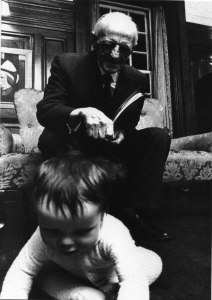Donald Winnicott observing a baby
When the external environment that gives us a sense of our place in the world is radically changed, and there is talk about who is ‘disposable’ and who is particularly vulnerable to dying from coronavirus then not only is mortality brought to mind, but also a fear of annihilation.
Shortly before Donald Winnicott died in 1971, he wrote his paper on ‘The fear of breakdown’ which was published in 1974. The idea he put forward is that fear of breakdown is the fear of a breakdown that has already been experienced. He saw it as a fear ‘of the original agony’ that led the person to develop various defences to avoid the experience. In other words the breakdown that is so feared has already been, but is still being carried around in the unconscious, because, at the time that it happened, the ego was too immature to encompass what was happening and integrate it. This general fear of breaking down can be specifically linked to a fear of death. As Winnicott writes this is a very common fear, and one absorbed in the religious teachings about an after-life – but if you fear death then the promise of an after-life gives no relief.
Instead, as Winnicott understands it, the person is compelled to look for death, and again this is the death that happened, but was not able to be experienced that is being looked for. When the poet John Keats was ‘half in love with easeful death’, he was, says Winnicott, longing for the relief that would come if he could ‘remember’ having died, but to do that he must experience death in the present. One solution that people consider is suicide, in other words sending the body to the death that has already happened to the psyche – but that is a despairing gesture.
‘Death, looked at in this way as something that happened to the patient but which the patient was not mature enough to experience, has the meaning of annihilation.’ The death that happened was a failure in the baby’s early infancy in his or her ‘facilitating environment’, perhaps a serious impingement in the baby’s sense of continuity of being.
To get this original experience of annihilation into ‘the past tense’, it has to be experienced and absorbed into the present time and so understood. As Winnicott says, if we can accept this strange truth that what is not yet experienced did nevertheless happen in the past, then the way is open for the agony to be released, and the present life to be fully lived (despite the virus) and to be open to whatever may come.
